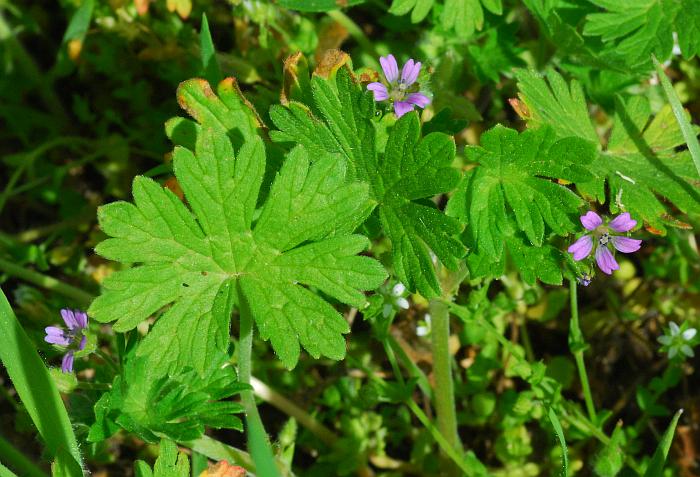Geranium pusillum L.
Small Crane's Bill

Introduced
CC = *
CW = 5
MOC = 20
© SRTurner
Geranium pusillum L.Small Crane's Bill | |
 |
Introduced CC = * CW = 5 MOC = 20 |
© SRTurner |
|
Family - Geraniaceae Habit - Annual or biennial, taprooted forb. Stems - To 50 cm, spreading or weakly ascending, moderately to densely pubescent with short, glandular and eglandular hairs.
Leaves - Basal and opposite, uppermost leaves sometimes alternate. Basal leaves long-petiolate, stem leaves with progressively shorter petioles. Blades to 4 cm, roughly orbicular, palmately 5-9 lobed, lobes obtriangular, sharply 3-lobed or toothed at the tip, surfaces pubescent with short eglandular hairs. Stipules 3 at each node, one of these formed by fusion of two others.
Inflorescences - Axillary pairs of flowers, these on stalks 5-15 mm long. Flowers - Sepals 3.0-4.5 mm long, ovate, tapered or narrowed to an inconspicuous, minute point at the tip, pubescent with longer, more or less spreading, nonglandular and sparse shorter glandular hairs. Petals 2.5-5.0 mm long, obtriangular, notched at the tip, pink. Stamens 5. Staminodes 5.
Fruits - Mericarps 9-12 mm long at maturity, the seed-containing basal portion 1.7- 1.9 mm long, the lateral surfaces smooth, minutely hairy, the stylar beak with minute ascending nonglandular hairs, narrowing directly from the columnar portion to the stigmas. Seeds 1.6-1.8 mm long, the surface appearing smooth or with a faint fine network of ridges and pits.
Flowering - April - August. Habitat - Forest openings, riverbanks, old fields, lawns, roadsides, moist disturbed areas. Origin - Native to Eurasia. Lookalikes - Geranium carolinianum, G. dissectum. Other info. - In appearance this plant is very similar to the native G. carolinianum, having palmately lobed leaves and small pink flowers. The flowers are even smaller, however, and they lack awnlike projections on the sepal tips. There are five stamens (and also five staminodes), which differentiates this species from G. molle. The plant has been collected mostly from the southwestern portion of the state. However, it is not uncommon at trailheads in east-central Missouri, probably being spread by mowing equipment. Its North American distribution includes scattered populations in most states. Since it is easily mistaken for G. carolinianum, it may be more common than reported. Photographs taken in Augusta, St. Charles County, MO, 5-5-2014 and 5-12-2017 (SRTurner). Focused stacked image of fruit by Rick Gray. |